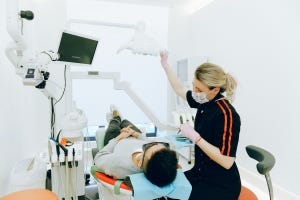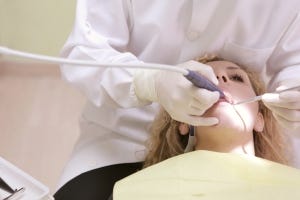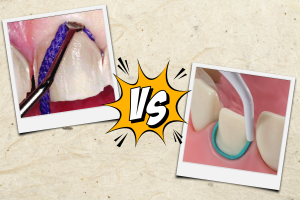What is Retraction Paste? And How Does it Compare to Packing Cord?

What is Retraction Paste & How Does it Compare to Packing Cord?
Retraction paste takes the place of packing cord or can be used in conjunction with cord. Considered to be easier, quicker and less painful for the patient than packing cord, retraction paste goes around the gingiva of the tooth and then the patient bites down on a retraction cap which each come in three sizes depending which tooth is being worked upon.
Dental laboratories insist on some sort of retraction whether it be cord or retraction paste when taking impressions for precise procedures like crowns and bridges. When taking impressions for a retainer or night guard, retraction is not necessary.
Retraction paste is purchased either in a syringe or a compule. Premier Traxodent is one of the most popular options which comes in both the syringe and compule delivery system. Traxodent is Premier Hemodent in a paste formation, which is non-staining and quick acting. And coming in a close second is Acteon Expasyl. Expasyl uses the compule style of delivery but uses a special application gun that is not generic.
One of the best advantages we see in using retraction paste over cord, is the paste helps stop the bleeding much better than cord without the use of Premier Hemodent or other hemostatic agents.
If you’re used to packing two cords and still feels the need to pack, that’s fine. Just pack your cord first and then layer with the retraction paste as your “second cord”.
Benefits of paste over cord
- efficiency
- better margins
- cost effective
- patient comfort
- saves time
- controls bleeding
And while there is honestly nothing wrong with packing cord, there are many, many brands with sizes ranging from triple zero (000) to three (3). The smaller the number, the thinner the cord. The most popular sizes of cord are 000, 00, 0, and 1. Numbers two and three are available in all brands, just not quite as big of movers. Plain cords can be dipped into Premier Hemodent to help control bleeding while packing into the gingiva. Another option is to have a pre-dipped cord, which normally goes by the term impregnated. Some doctors like this cord by itself and some still feel the need to dip into a hemostatic agent to get the job done “better”.
Cords are either braided or knit. One is not better than the other, it’s just more of a personal preference. When packing cord, knowing whether you are using braided or knit is important on which cord packing instrument you use. Braided cords should be packed with serrated packers while knit cords are best packed with non-serrated cord packers. There are many options of cord packers available. Some are angled, some are round like a circle, some flat like a composite instrument, and some are thinner than others.
Explore our collection retraction paste and packing cords.



